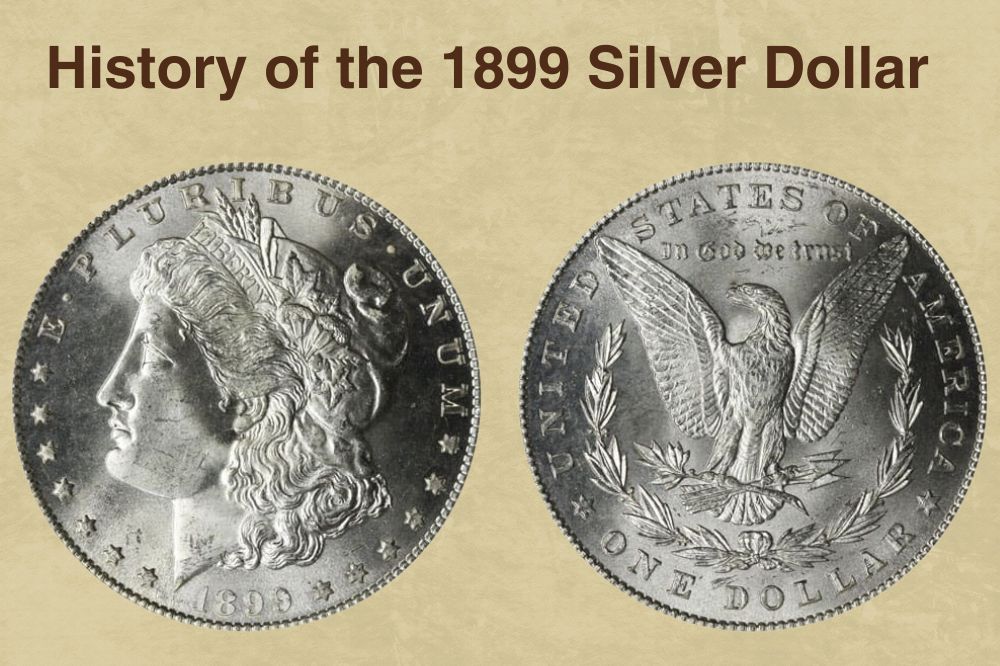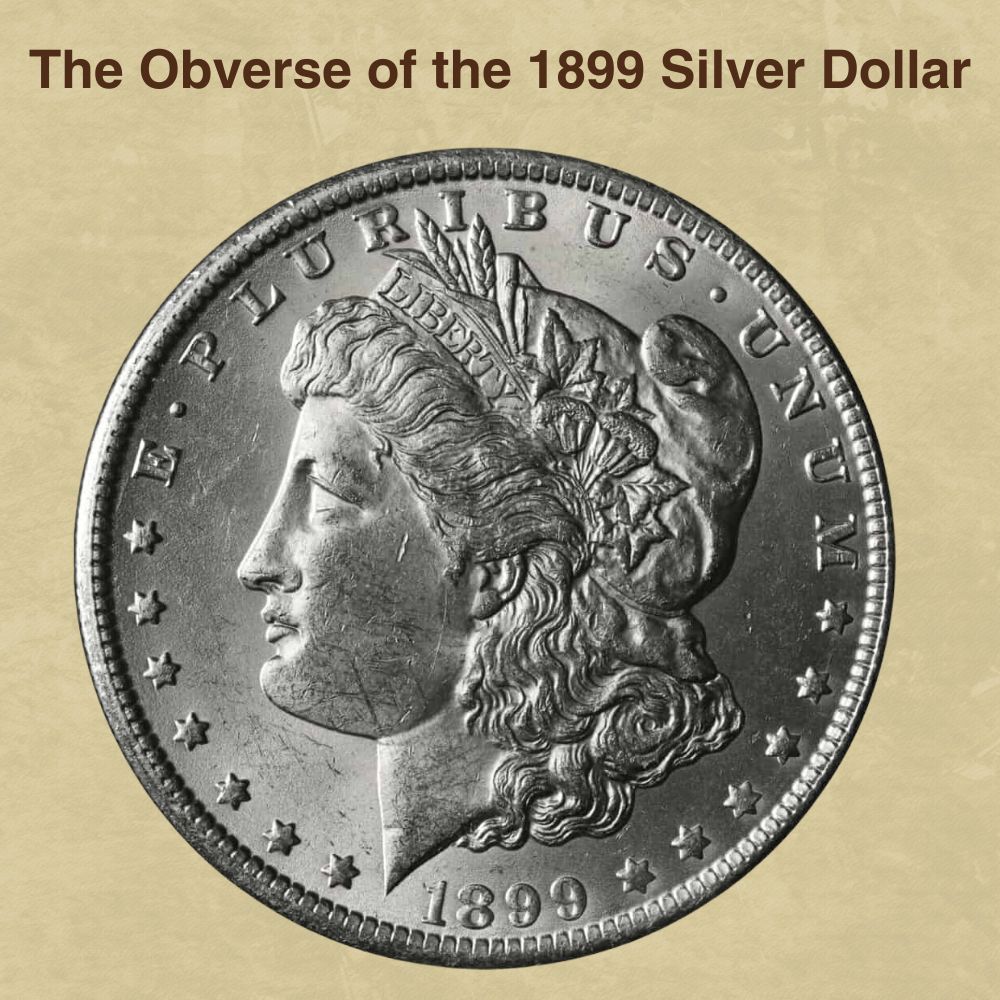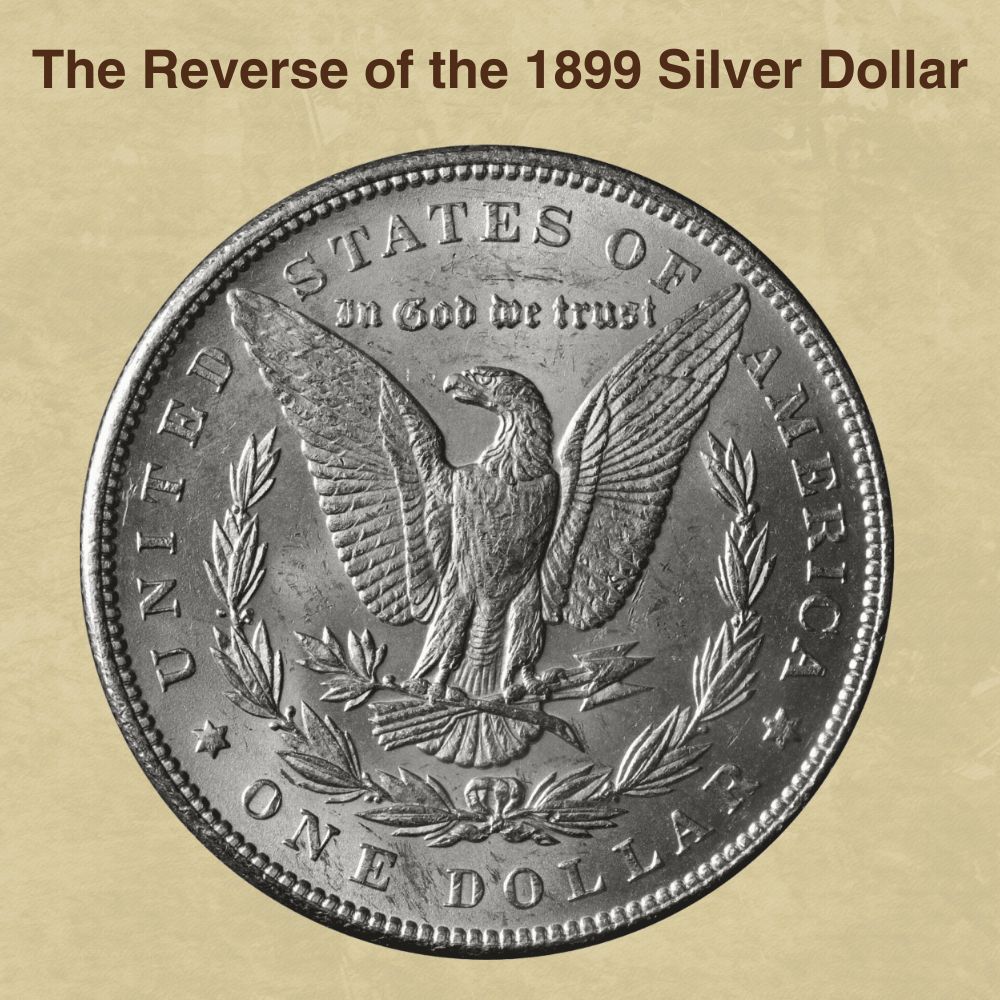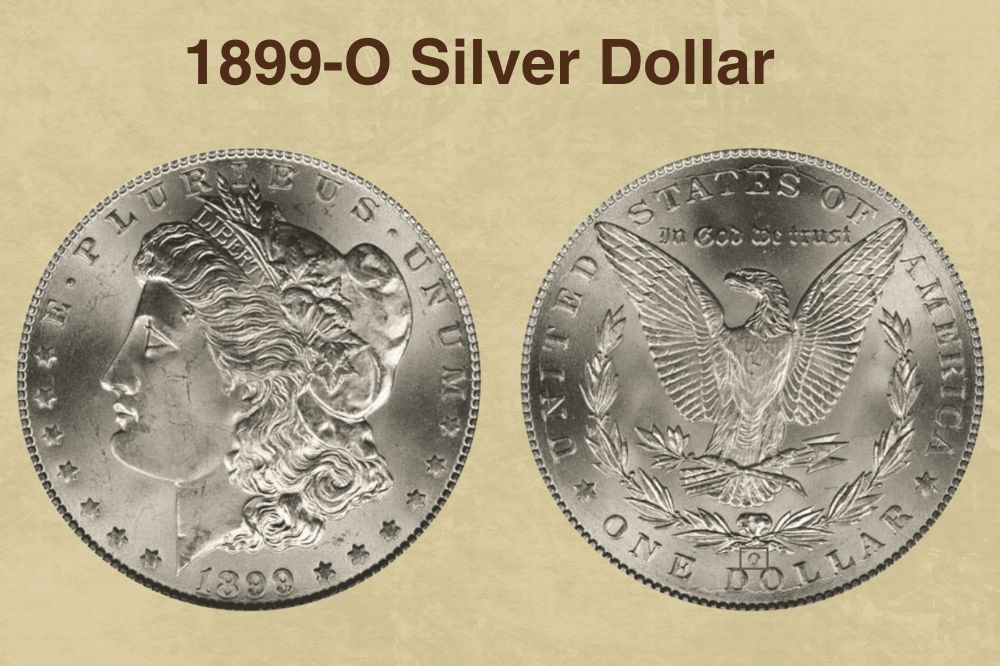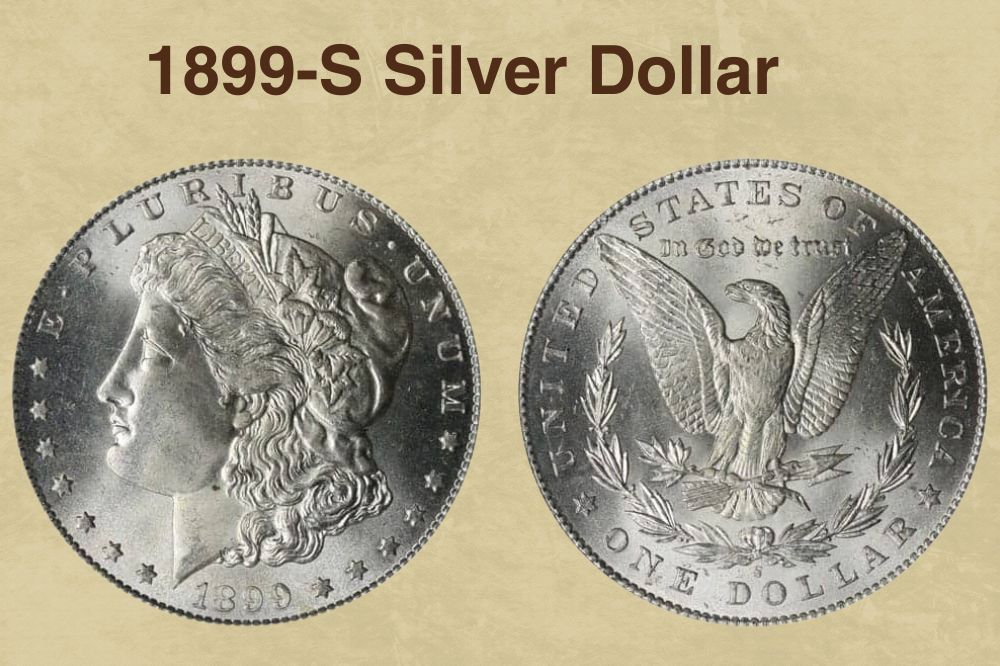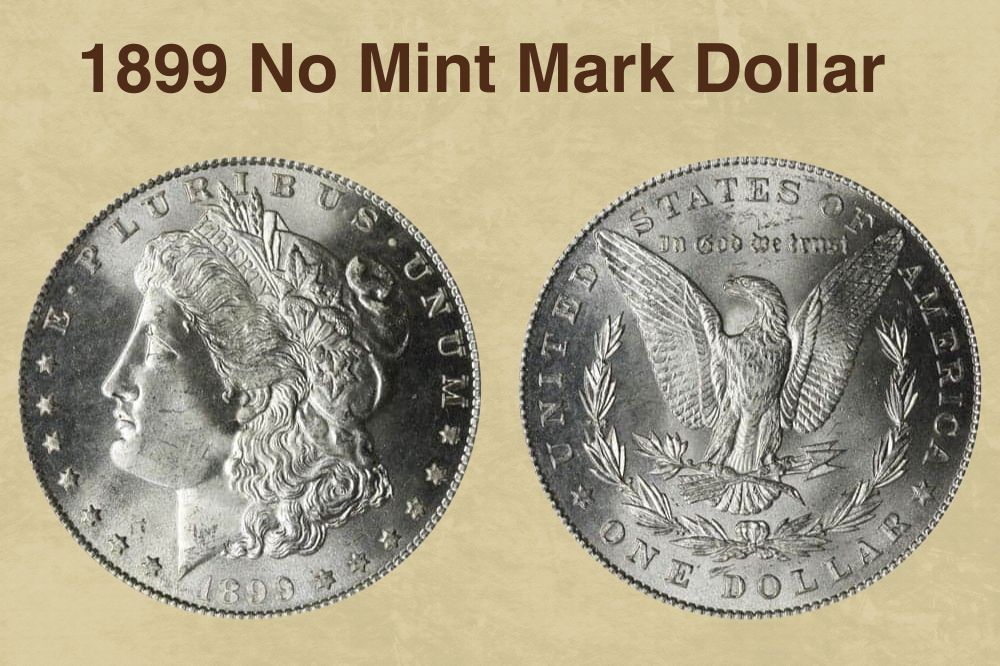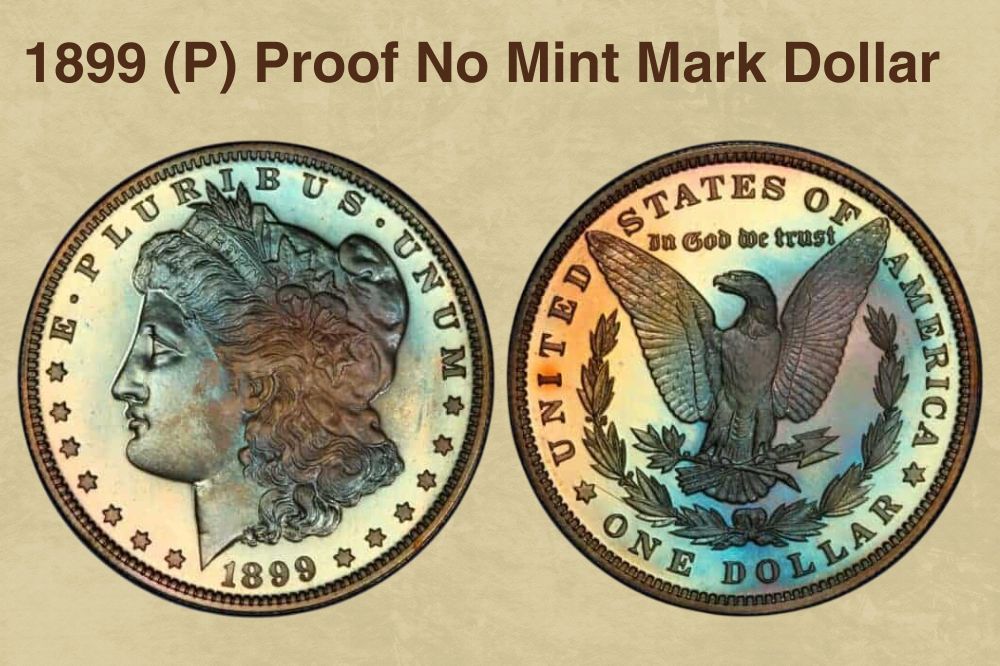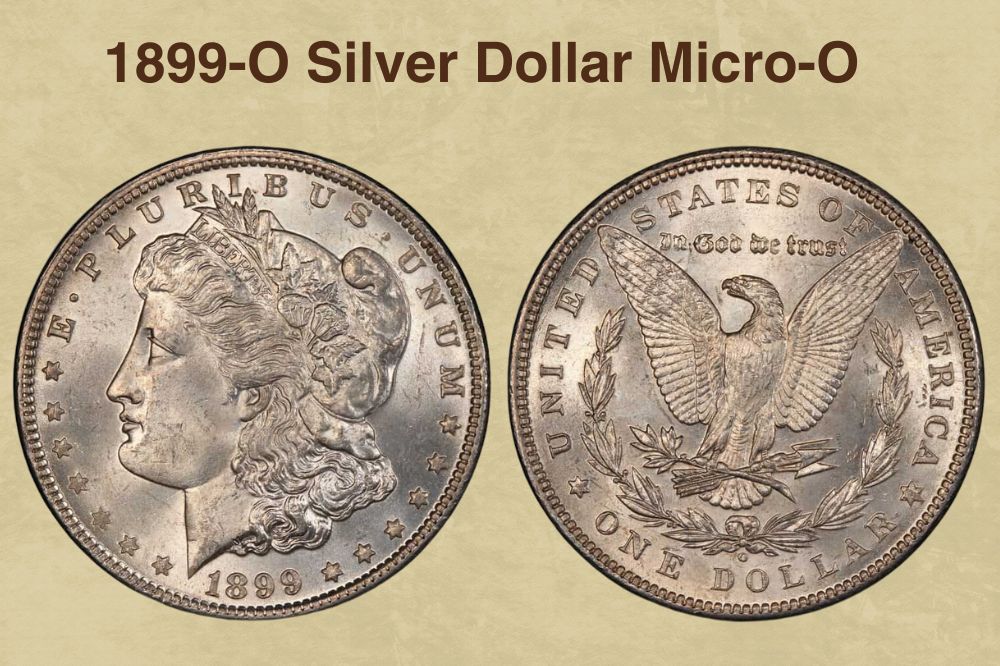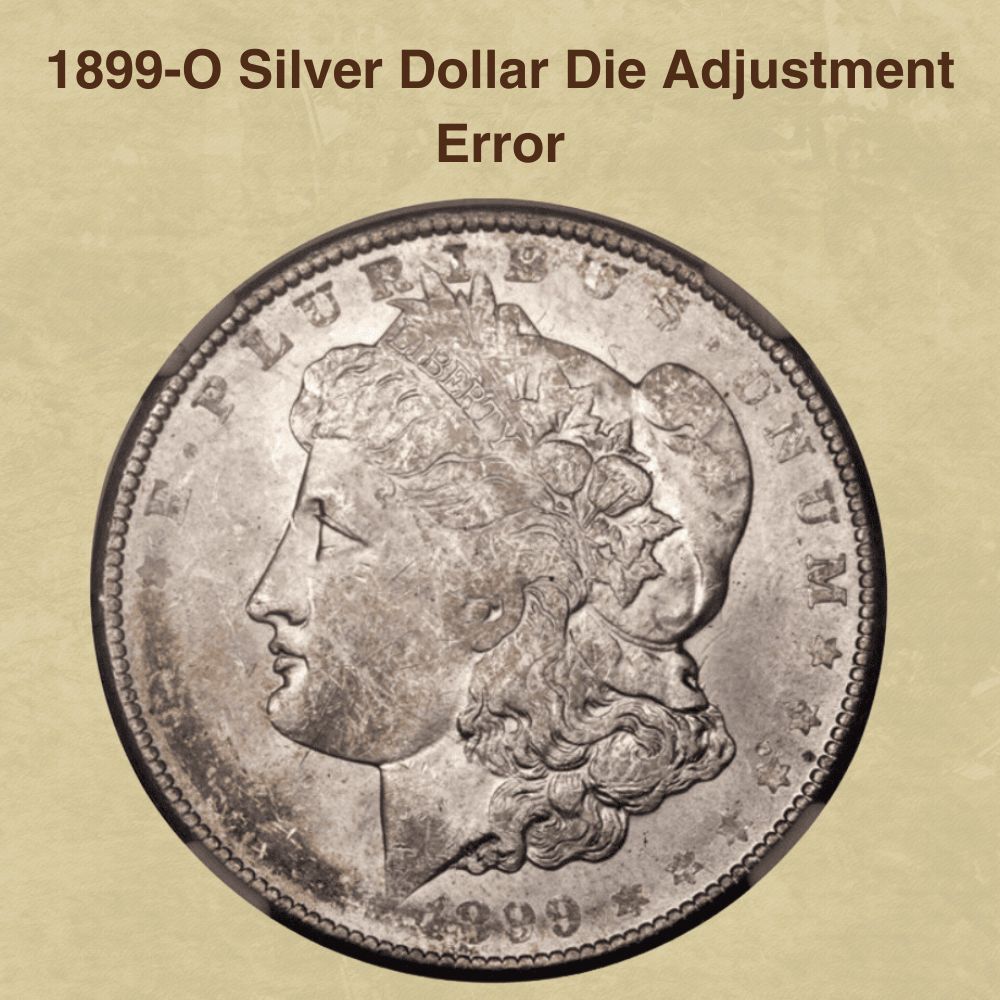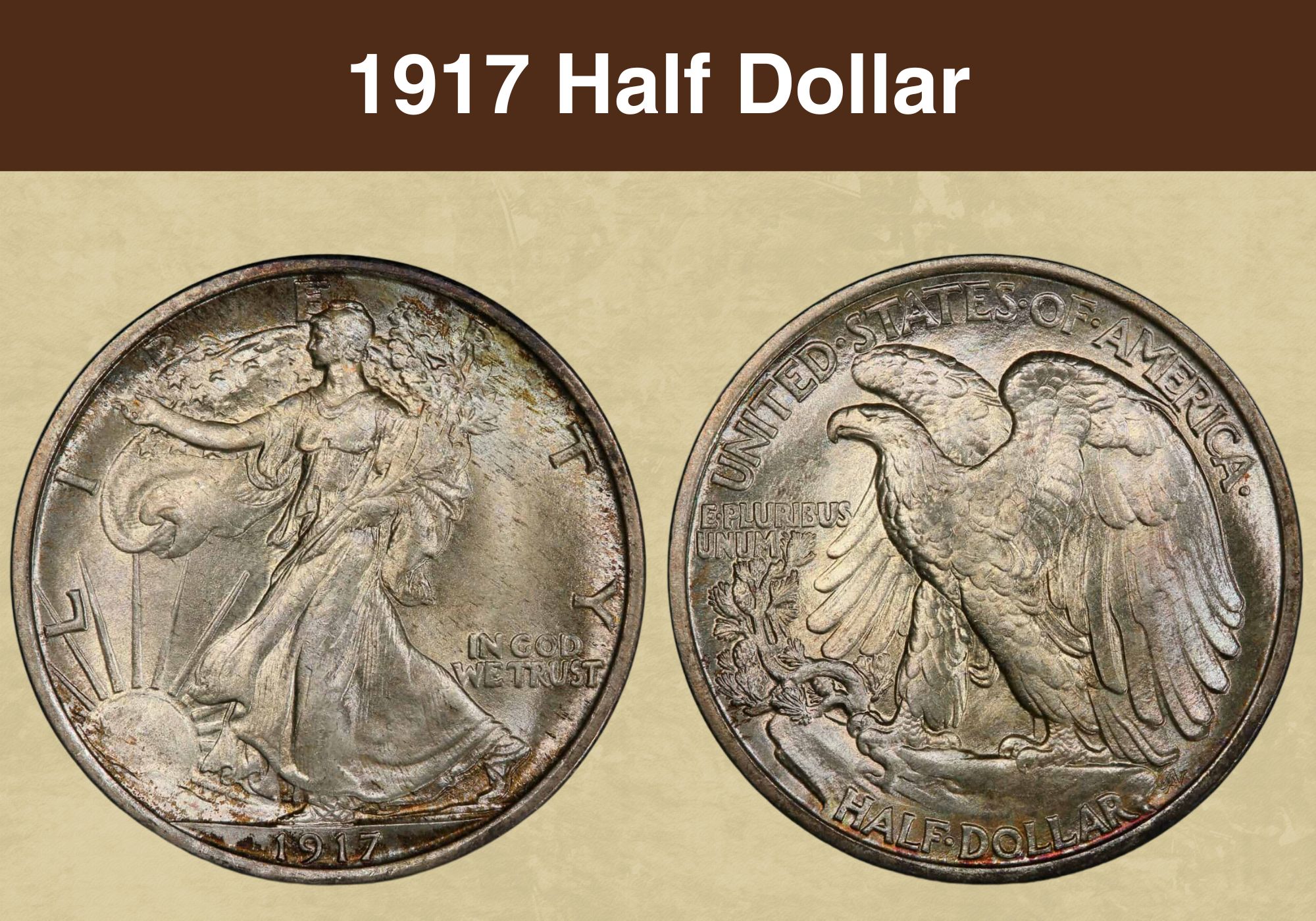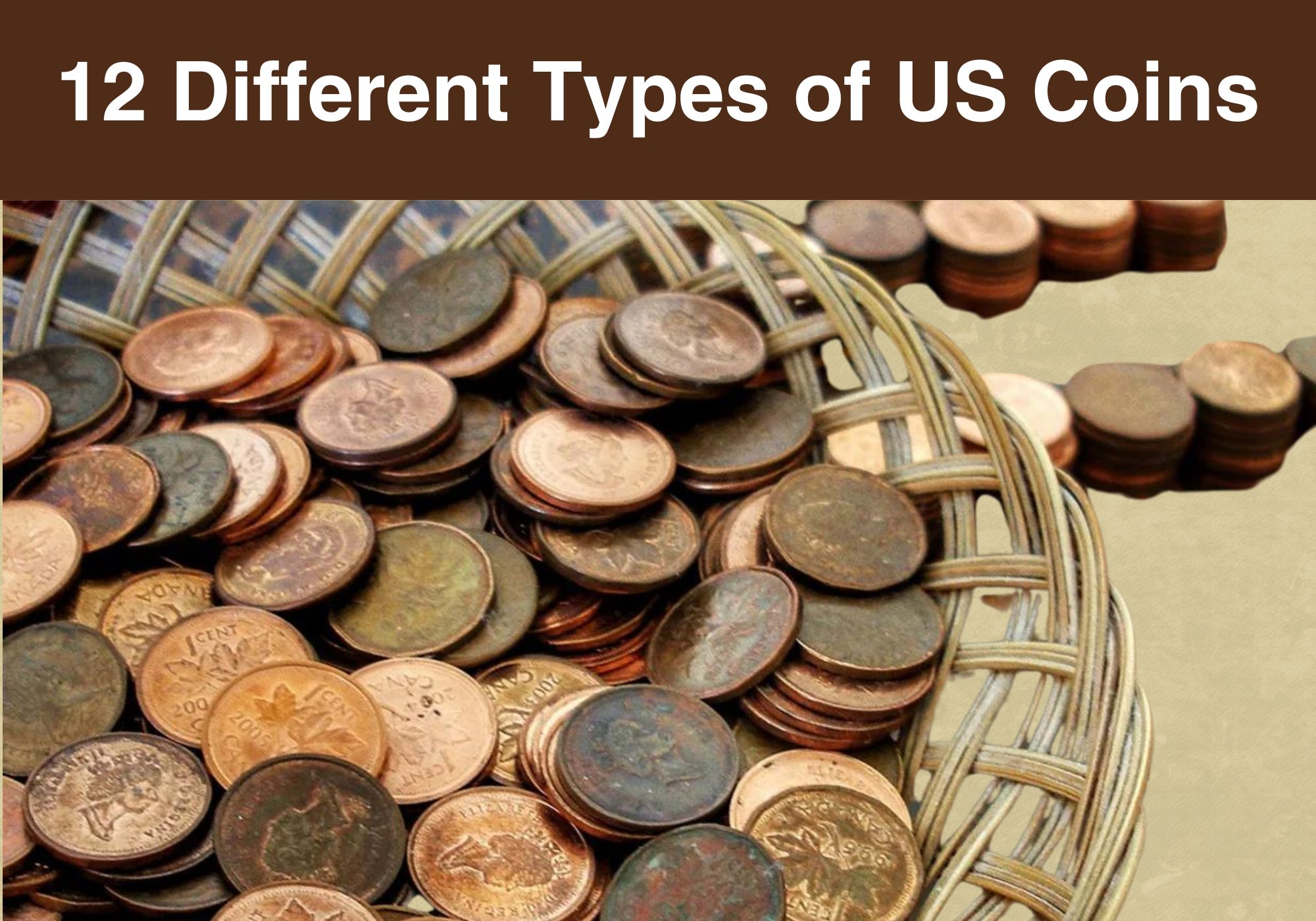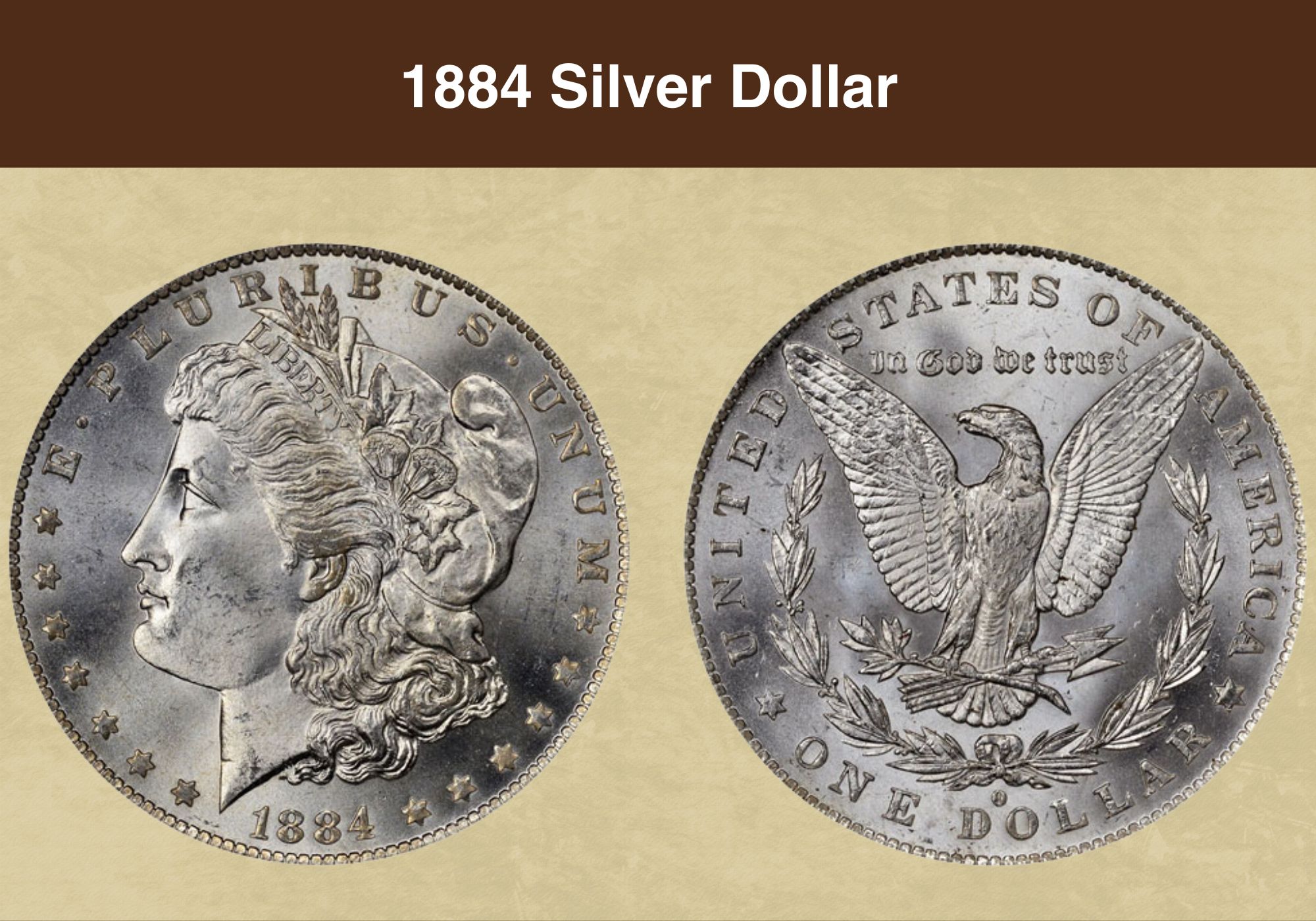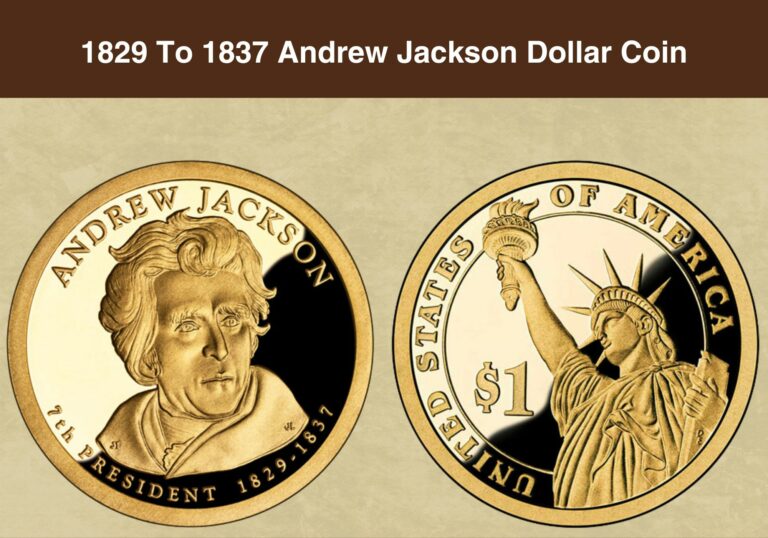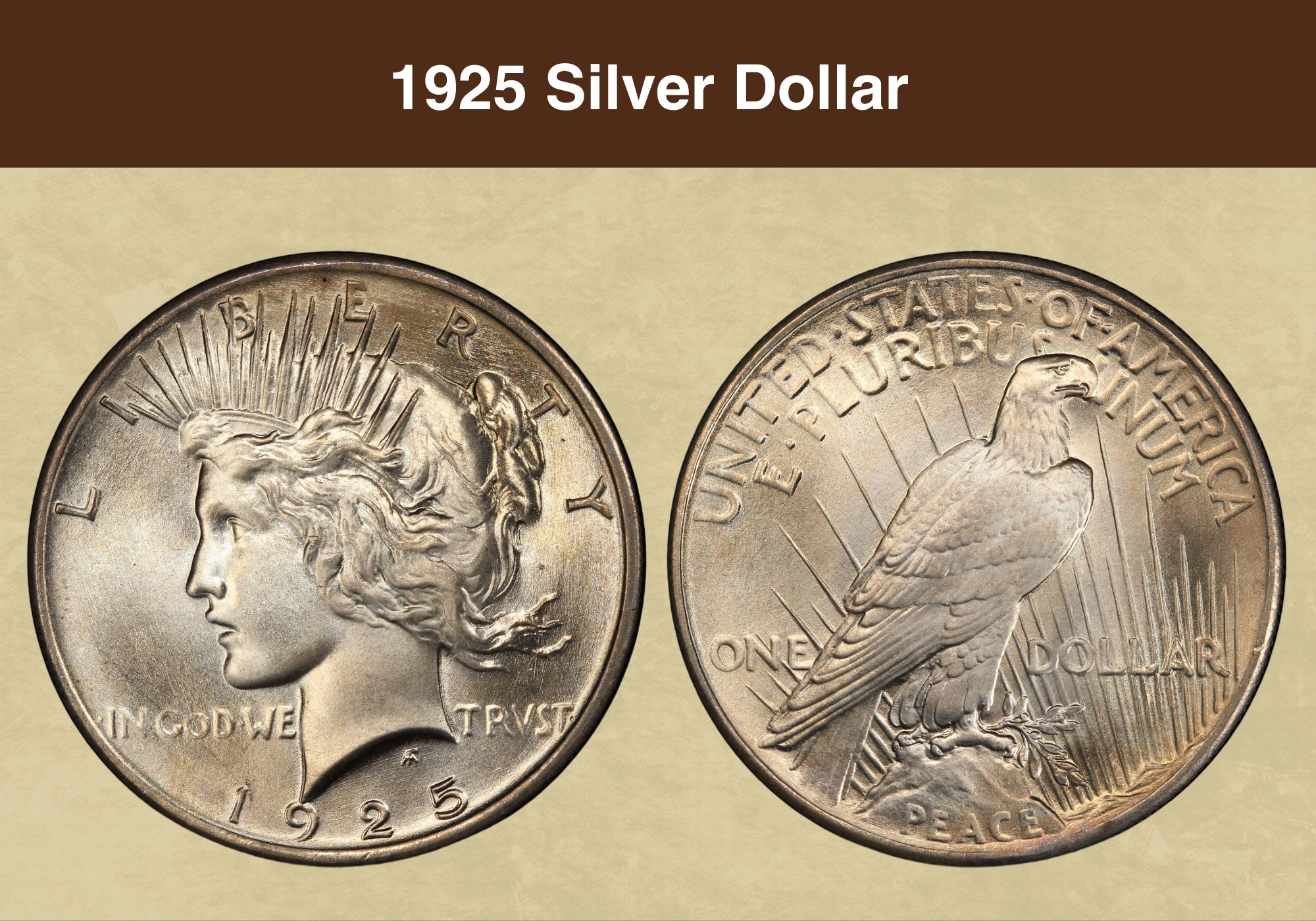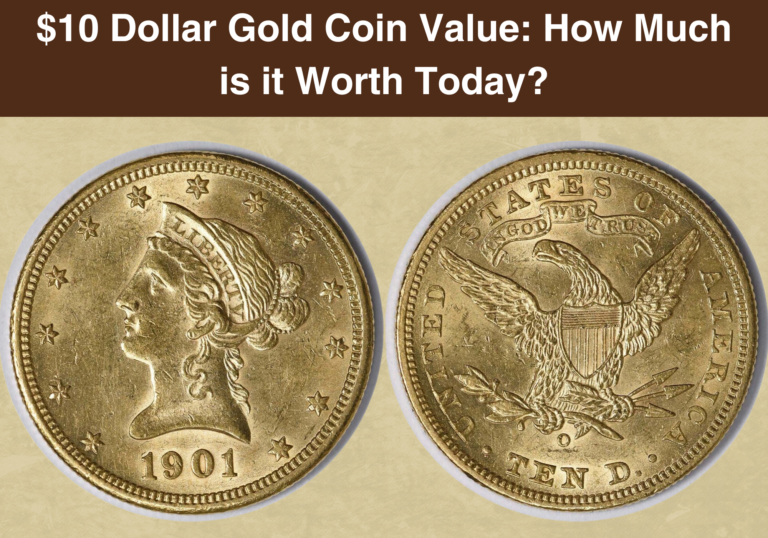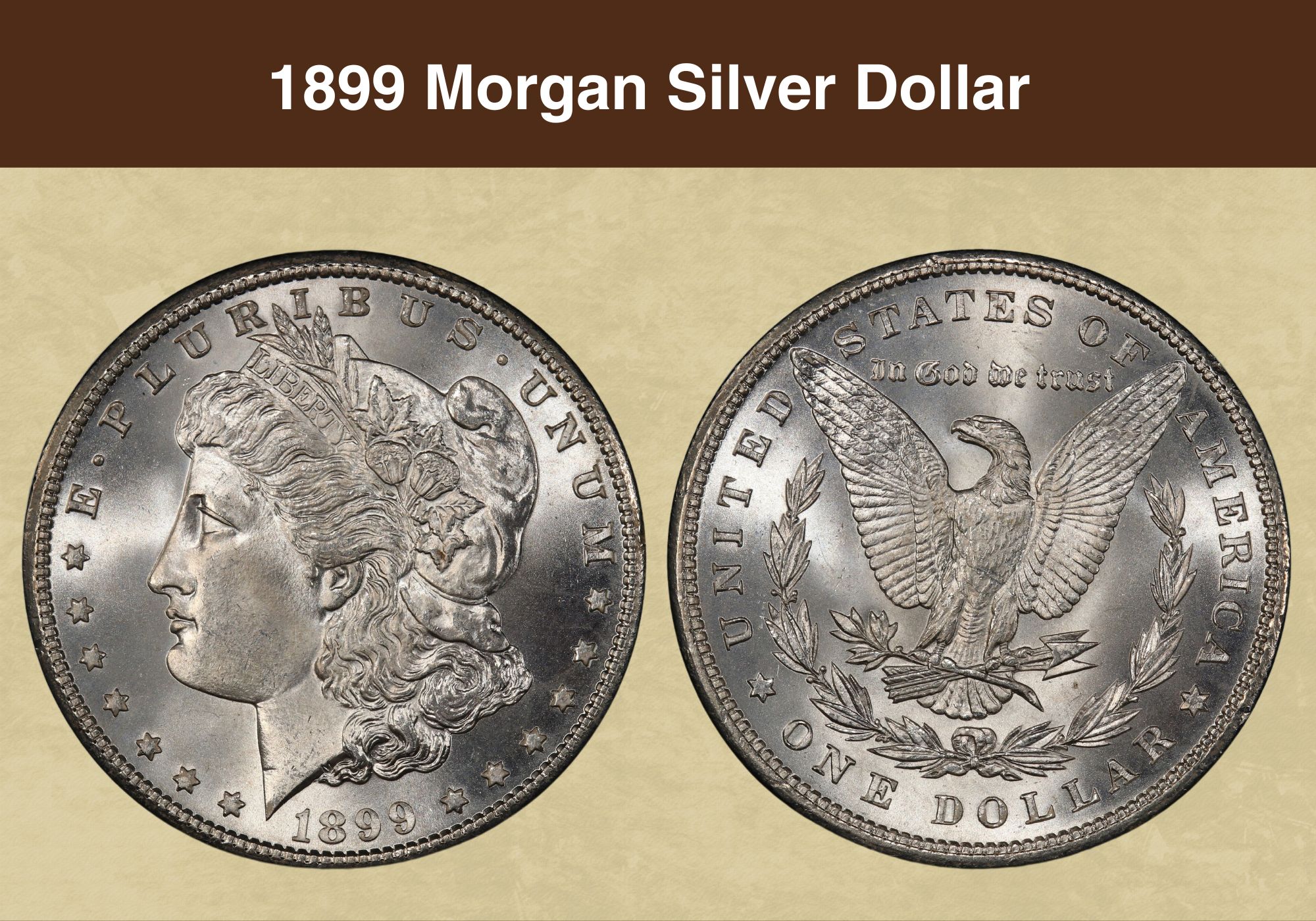
Coin Value Contents Table
- 1899 Silver Dollar Value Chart
- History of the 1899 Silver Dollar
- Features of the 1899 Silver Dollar
- 1899 Silver Dollar Grading
- 1899 Silver Dollar Value Guide
- 1899-O Silver Dollar Value
- 1899-S Silver Dollar Value
- 1899 No Mint Mark Dollar Value
- 1899 (P) Proof No Mint Mark Dollar Value
- Rare 1899 Silver Dollar Errors List
- Where to Sell Your 1899 Silver dollar ?
- 1899 Silver Dollar FAQ
At the end of the 19th Century, the Morgan Silver Dollar was regularly minted. People didn’t use it much except as backing for their Silver Certificates. It’s been a hundred years but most Americans still prefer $1 bills and $1 coins. But today, we’re more interested in the Morgan Dollar’s investment potential. So let’s review the 1899 Silver Dollar Value and find out more.
1899 Silver Dollar Value Chart |
||||||
| Coin | MS 60 | MS 63 | MS 64+ | MS 66 | MS 67+ | PR/PF 69 CAM |
| 1899-O Silver Dollar | $75 | $100 | $190 | $475 | $8,000 | – |
| 1899-O Silver Dollar Proof-Like | $100 | $185 | $315 | $1,450 | – | – |
| 1899-O Silver Dollar Deep-Mirror Proof-Like | $190 | $525 | $900 | $9,000 | – | – |
| 1899-O Micro-O Silver Dollar | $2,500 | $15,000 | $30,000 | $92,500 | – | – |
| 1899-S Silver Dollar | $625 | $1,150 | $1,550 | $5,850 | $52,500 | – |
| 1899-S Silver Dollar Proof-Like | $650 | $1,300 | $2,000 | $6,250 | – | – |
| 1899-S Silver Dollar Deep-Mirror Proof-Like | $900 | $2,800 | $12,000 | $36,000 | – | – |
| 1899 (P) No Mint Mark Silver Dollar | $290 | $450 | $750 | $3,000 | $27,500 | – |
| 1899 (P) No Mint Mark Silver Dollar Proof-Like | $335 | $525 | $900 | $3,150 | – | – |
| 1899 (P) No Mint Mark Silver Dollar Deep-Mirror Proof-Like | $350 | $775 | $1,650 | $7,000 | – | – |
| 1899 (P) Proof No Mint Mark Silver Dollar | – | – | – | – | – | $175,000 |
History of the 1899 Silver Dollar
We sometimes forget that technically, apart from Native Americans, we all arrived from somewhere else. And our earliest settlers came from Spain, France, Great Britain, and other parts of Europe. Once we got here, we created our own culture and worldview, but we still sought guidance from colonial powers. It’s why our key institutions were based on the Brits.
First, we used English, French, and Spanish currency to trade within our borders. Then we started our own mint in 1792, drawing our first few engravers from across the pond. Robert Scot was born in Scotland and moved to the US at age 30. Two decades later, he became the 1st Chief Mint Engraver. The next three (Kneass, Gobrehct, Longacre) were American-born.
But the 5th Chief Mint Engraver, William Barber, was born in London. His father and son were part of the same family business, and his son, Charles Barber, eventually succeeded him as the 6th Chief Mint Engraver. But before that, William Barber needed outside help to create a new Silver Dollar. Naturally, he reached out to contacts in Great Britain to find someone.
At the time, Charles Barber was already working at the mint as an Assistant Engraver. But Charles was born in the USA and the mint wanted someone with old-world training. This was especially important because William’s own design for the new dollar had been rejected, so the Mint Director, Henry Linderman, asked the Royal Mint Deputy for recommendations.
Silver Dollars Wrought in England
Over in the UK, the Deputy Master – C. W. Freemantle – suggested George T. Morgan for the job. The plan was to have him train under William Barber for six months. He ended up staying until his death in 1925. That said, Charles Barber ascended to the Chief position first. Morgan only served as Chief Mint Engraver for 8 years after Charles Barber died in office.
But Morgan’s legacy was built around the Silver Morgan Dollar, which circulated from 1878 to 1921. It was the local answer to William Barber’s Silver Trade Dollar since Trade Dollars were pushed overseas and rarely used within the US. The Morgan Dollar was introduced at the tail end of the Trade Dollar’s tenure, though they had some overlap in 1878 and 1879.
As we’ve seen, the 1899 Silver Dollar was a Morgan and it was coined at three mints – San Francisco, New Orleans, and Philadelphia. Prior American coins had used a symbolic and imaginary face for Miss Liberty, often derived from Ancient Greek and Roman styling of the goddess. Draped Bust coins (1796 to 1807) were said to be based on Ann Willing Bingham.
But the others used generic female features that were borrowed from previous coins. It’s why the Gobrecht, Seated Liberty, and Trade Dollar are so similar. In Morgan’s case, he decided to try using a living American woman as his muse. A friend suggested Anna Willess Williams. She was a quiet schoolteacher who had posed before but wanted to have her identity hidden.
Also read: 12 Most Valuable One-Dollar Coin Worth Money
Features of the 1899 Silver Dollar
Let’s start by defining the numismatic jargon. Numismatics is the study of medals, tokens, and coins. The heads side of a coin is the obverse, the tails side is the reverse, the thin side is the edge, and the raised border is the collar or rim. The words are legends or mottos, the images are devices, and the background is the field. The blank coin disc is called a planchet.
The Obverse of the 1899 Silver Dollar
It shows Lady Liberty facing left. She’s wearing a Phrygian cap stuffed with wheat and cotton plants. She also has a headband with the legend Liberty. The top of the coin says E Pluribus Unum while the bottom has the mint date. 13 stars fill the rest of the rim. On the neckline cut-off, next to the lowest lock of hair, there’s a well-hidden M for Morgan, the coin designer.
The Reverse of the 1899 Silver Dollar
It shows a bald eagle with its wings pointing up. The bird has three arrows and an olive sprig in its talons. Below the bird is an olive wreath tied with a ribbon. The mint mark is under the knot on the ribbon, and the left ribbon loop has a barely visible M for Morgan. The top of the coin says United States of America and In God We Trust. The bottom collar says One Dollar.
Other Features of the 1899 Silver Dollar
The 1899 Silver Dollar was 90% Silver and 10% Copper, weighed 26.73g, measured 38.1mm in diameter (1.5”), and was 2.4mm thick. It had 412.5 grains of fine silver and reeds along its edge. The leaves in Miss Liberty’s cap are sometimes mistaken for maple since maple leaves look a lot like smaller cotton leaves. So you’ll often find maple in Morgan Dollar descriptions.
Also read: 14 Most Valuable Coins In Circulation
1899 Silver Dollar Grading
All coins are graded using the Sheldon Scale which goes from 1 to 70. But the wording differs from country to country. In America, 60 to 70 are Mint State coins but some places refer to those grades as Uncirculated. In other places, Uncirculated coins are 50 to 58. Either way, the clarity of features can help you estimate the coin’s condition before sending it to appraisers.
| # | Grade |
|---|---|
| 1 | Basal State-1 |
| 2 | Fair |
| 3 | Very Fair |
| 4, 5, 6 | Good |
| 7, 8, 10 | Very Good |
| 12, 15 | Fine |
| 20, 30 | Very Fine |
| 40 | Extremely Fine |
| 50 | About Uncirculated |
| 60 | Mint State |
| 65 | Mint State |
| 70 | Mint State |
Please check our grading guides to know your coin scale, It’s the necessary step to know the exact value of your coin.
Check out now: How to Grade Morgan Silver Dollar?
1899 Silver Dollar Value Guide
As we said before, 1899 Silver Dollars were minted in New Orleans, Philadelphia, and San Francisco. The mint mark can affect the value of a coin, but so can the condition and rarity. Coins that are used in everyday transactions are called business strikes or regular strikes but collectible coins include mirror-like proofs, reverse proofs, and satin-finish aka matte proofs.
Sometimes, highly glossy business strikes are graded PL for proof-like or DMPL for deep-mirror-proof-like. These coins weren’t made with specialized proof dies and proof planchets, but their visual attractiveness can raise their resale value. Also, among verified proofs, Deep Cameo coins fetch the best prices. But they’re the hardest to come by, especially on old dates.
1899-O Silver Dollar Value
The New Orleans Mint made 12,290,000 Silver Dollars in 1899, all with the O Mint Mark. Most were minted with a regular-sized O but an unknown number had a smaller Micro-O. Since it was a die error, the Micro-O became a variety, but we’ll focus on the normal O here and cover the Micro-O in the error section. An MS 68 sold for $29,900 on 1st January 2009.
Only three have shown up so far, so that has risen slightly to $37,500 in August 2023. The PLs aren’t doing as well though, with an MS 67 PL only going for $4,320 in December 2022. The two known samples are worth $5,000 today. Meanwhile, an MS 67 DMPL was worth $16,100 in July 2008. Two samples are known in this grade, so they’re now worth $21,500.
1899-S Silver Dollar Value
The San Francisco Mint made 2,562,000 Silver Dollars in 1899, all with the S Mint Mark. A PO 1 is worth about $70. In 2015, an MS 67+ sold for $49,938. With only 2 samples known, their value in August 2023 is $52,500. Meanwhile, an MS 67 PL was $36,425 in 2021 and an MS 65 DMPL sold for $27,600 in 2008. Today, the four MS 66 DMPLs are worth $36,000.
1899 No Mint Mark Dollar Value
In 1899, the Philadelphia Mint made 330,000 Silver Dollars without mint marks. And in 2015, an MS 67+ sold for $21,150. It’s a pretty valuable coin. In August 2023, even the lowest grade of PO 1 is worth $120 since only 4 exist. And the three MS 67+ samples are currently worth $27,500. An MS 66+ PL was $7,344 in 2019 and an MS 66 DMPL was $8,338 in 2007.
1899 (P) Proof No Mint Mark Dollar Value
It’s easy to identify a mirror-like proof coin because of its highly reflective field and frosted device. But it’s about more than looks. Proof coins get special treatment long before minting begins. The blanks are tumbled in vats full of 6mm stainless steel balls to produce that shiny effect. And Proof Die fields are scrubbed with horsehair to make the field more mirror-like.
Meanwhile, the Proof Die Device is either pickled in acid or textured with computerized lasers. In the prior method, the corrosion reduces slightly every time the die hits a planchet. That means the earliest 50 to 100 coins are Deep Cameo or Ultra Cameo, the next hundred or so are Cameo, and the remaining coins are standard proofs. This directly affects pricing.
In 1899, the Philadelphia Mint only made 846 Proof Silver Dollars. This extreme rarity plus their antique status makes them quite valuable. A PR 69 sold for $126,500 in 2007. And a PR 68+ CAM was $144,000 in January 2022. Today, a PR 69 CAM is estimated at $175,000. But a decade ago, a PR 67+ DCAM was just $44,063. That’s risen to $57,500 in August 2023.
Also read: Top 10 Most Valuable Morgan Silver Dollar Worth Money
Rare 1899 Silver Dollar Errors List
Lots of Morgan Dollars were melted and sent to the UK in 1918 during the First World War. Lots more lived in bank vaults since they were too bulky for everyday transactions. Plus, the coins are true antiques – over 100 years old! And spotting a mint mistake on these coins can make them even more valuable. So let’s take a look at the prices of 1899 Silver Dollar Errors.
1899-O Silver Dollar Micro-O
On older coins, the mint mark was placed on the die by hand, and it was the last detail added to the coin. Mint mark mistakes include RPMs (re-punched) and OMMs (over-mint-mark). Here’s a micro-mint mark, possibly taken from a 25c coin (Quarter). An MS 62 was $16,800 in 2018 and an MS 66 was $73,438 in June 2015. That increased to $92,500 in August 2023.
1899-O Silver Dollar Broadstrike
The rim of a coin keeps it perfectly round and ensures every coin has the same diameter, width, and amount of metal. The collar also facilitates coin stacking. In the past, a three-piece mold was used to make the rim. Today, we use an upsetting machine. But if the rim is flattened or incomplete, that’s called a broadstruck error. This example sold for over $515.
1899-O Silver Dollar Die Adjustment Error
To make coins, the obverse and reverse die simultaneously hit the coin at a pre-set pressure. If the pressure is too low, the design will be blurry or invisible. If it’s too high, the coin may get deformed. So die pressure is tested to get the setting right. Flawed coins produced during the process may have die adjustment errors. This one was authenticated and it sold for $730.
1899-O Silver Dollar Struck 5% Off-Center
Feeder fingers slide blanks into the press, positioning them right between the dies. But the blank may slip, leaving part of its surface unmarked. This is called an off-center error and the misalignment is measured in percentages. The higher the figure, the more the coin is worth. This one was only 5% off-center but it’s graded MS 60 so the coin sold for more than $2,700.
Where to Sell Your 1899 Silver dollar ?
Now that you know the value of your coins, do you know where to sell those coins online easily? Don’t worry, I’ve compiled a list of these sites, including their introduction, pros, and cons.
Check out now: Best Places To Sell Coins Online (Pros & Cons)
1899 Silver Dollar FAQ
What Makes the 1899 Silver Dollar Rare?
Several reasons. It’s an antique that’s been around for 125 years so you’re unlikely to bump into one. And they made less than a thousand proof coins, so those are even rarer. The total mintage for all three mints (Philadelphia, New Orleans, and San Francisco) was about 15M, much lower than mint volumes today. Philadelphia alone had just 330,000 Silver Dollars.

